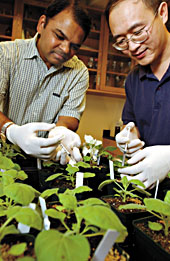
|
"Infectious plant diseases result in multibillion-dollar crop losses each year," says S.P. Dinesh-Kumar, assistant professor in the Department of Molecular, Cellular and Developmental Biology and principal investigator on the study.
"Since the world population is expected to double over the next 50 years, increased knowledge of plant genes, genomes and how to manipulate them will greatly aid in feeding this growing population," he adds.
Dinesh-Kumar and his collaborators are particularly interested in plants' hypersensitive response (HR), which he says is one of their "most powerful weapons" against pathogen attack. The HR is characterized by rapid cell death at the site of infection.
This cell death response, he explains, likely benefits the plant by depriving pathogens (such as bacteria, fungi, viruses and nematodes) of access to nutrient source, thereby limiting their proliferation.
The grant will enable Dinesh-Kumar and his collaborators -- among them Hongyu Zhao, associate professor in the Departments of Genetics and of Epidemiology and Public Health at the School of Medicine -- to develop and use functional genomics and proteomics tools to understand the molecular mechanisms by which viruses evade the host's antiviral defenses.
Dinesh-Kumar says the research team will use a fast-forward genetic approach called virus-induced gene silencing (VIGS) and proteomics to identify genes involved in disease resistance and susceptibility. VIGS and RNA interference in animal systems enable researchers to link a gene to its function reliably and quickly by silencing their activity.
T H I S
Bulletin Home
 W E E K ' S
W E E K ' S S T O R I E S
S T O R I E S![]()
 NSF funds study to curb crop losses
NSF funds study to curb crop losses
![]()
![]()
 Campus marks anniversary of Sept. 11 terrorist attacks
Campus marks anniversary of Sept. 11 terrorist attacks![]()
![]()
 Sept. 21 is 'Yale Employee Day at the Bowl'
Sept. 21 is 'Yale Employee Day at the Bowl'
![]()
![]()
 Slavery's impact on Yale and New Haven to be explored
Slavery's impact on Yale and New Haven to be explored![]()
![]()
 Corporation names new senior fellow
Corporation names new senior fellow![]()
![]()
 ENDOWED PROFESSORSHIPS
ENDOWED PROFESSORSHIPS![]()
 In new programs, school partners with local health centers . . .
In new programs, school partners with local health centers . . .![]()
![]()
 Exhibit explores Romantic artists' interest in the natural world
Exhibit explores Romantic artists' interest in the natural world![]()
![]()
 Library displays book covers in 'Gleaming Gold, Shining Silver'
Library displays book covers in 'Gleaming Gold, Shining Silver'![]()
![]()
 Newer antipsychotic medication helps curb some of the behavioral problems . . .
Newer antipsychotic medication helps curb some of the behavioral problems . . .![]()
![]()
 Noted Taliban expert and journalist will speak on campus
Noted Taliban expert and journalist will speak on campus![]()
![]()
 SOM Dean to kick off campus United Way campaign
SOM Dean to kick off campus United Way campaign![]()
![]()
 Forum will boost public knowledge about forest certification . . .
Forum will boost public knowledge about forest certification . . .![]()
![]()
 Event celebrates Cuban literature
Event celebrates Cuban literature![]()
![]()
 Images from the Sept. 11 commemoration activities on campus
Images from the Sept. 11 commemoration activities on campus![]()
![]()
 Library appoints four new senior department heads
Library appoints four new senior department heads![]()
![]()
 Yale senior picked as one of Glamour's top 10
Yale senior picked as one of Glamour's top 10![]()
![]()
 Back near Broadway
Back near Broadway![]()
 |
| Visiting on Campus
Visiting on Campus |
| Calendar of Events
Calendar of Events |
| In the News
In the News |
| Bulletin Board
Bulletin Board![]()
Yale Scoreboard |
| Classified Ads
Classified Ads |
| Search Archives
Search Archives |
| Deadlines
Deadlines![]()
Bulletin Staff |
| Public Affairs Home
Public Affairs Home |
| News Releases
News Releases |
| E-Mail Us
E-Mail Us |
| Yale Home Page
Yale Home Page